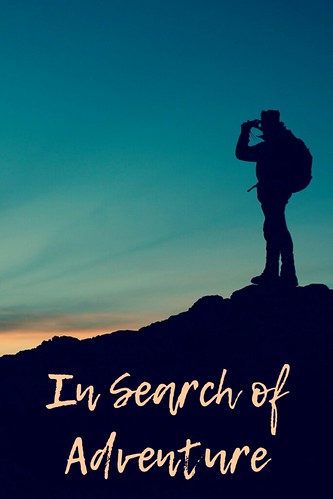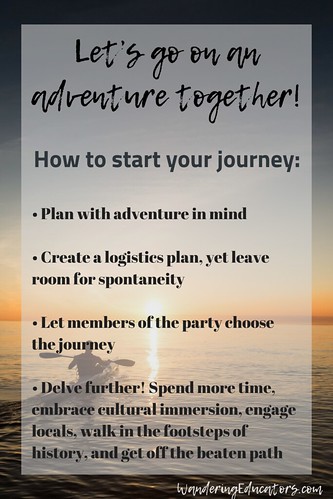Every day, students show up to learn. Whether they’re five years old in a traditional classroom or fifteen in a home school setting - or anywhere in between - there's curiosity, intrigue, and interest somewhere inside them waiting to be entertained and engaged. Some show up craving the excitement of learning, while others are there without any excitement, unless that necessary hook can grab their attention. Long ago, one of my favorite quotes grabbed my attention and hasn’t let go since.
“Actually, the best gift you could have given her was a lifetime of adventures.” ~ Unknown

When adventures are involved, excitement and engagement are elevated. We’ve all seen the faces of little ones (and those young at heart) light up when a surprise trip is announced, and watched with glee as the level of anticipation continues to creep in when the planning stages of a journey ensue.
How can we capture those elements in our lessons?
How can we engage students and learners with that level of excitement on a more regular basis?
How can we insert that ‘adventure attitude’ into what young learners might find trite, not at all useful, or an utter waste of time?
Let’s go in search of adventure together, and find a way to involve each learner in a way that he or she can grab hold of, make his or her own, and excel in along the way.
Think about your adventures - how did you choose them, what went into planning them, who did you take with you, and why did you want to go?
Let’s add those elements into the Blooms Taxonomy we often use to guide learning.
Let’s infuse that adventure spirit into the levels that range from lower ordered thinking to higher ordered thinking. Terms such as ‘knowledge/remember, comprehension/understand, application/apply, analysis/analyze, synthesis/evaluate, and evaluation/create” are used in classrooms around the globe to assist in the learning process, planning process, and creation of rubrics and standards of curriculum development. Lessons are planned, projects are designed and assessments are created to gauge the levels of learners in each of these tiers.
What if we threw adventure into the mix? Could it hit every level? Could it make a difference in the speed at which a learner jumped from one tier to the next? Could it change the level of engagement along the way? How can that adventure blend the tiers, mix amongst the subject matter, and regardless of the topic at hand, flip the script from boring to engaging?
What changes, if we look at our lessons with a different angle and a different eye?
How does that new outlook shift our perspective, our daily aims, and the overall schematic of our curriculum development? Regardless of subject or concept, if we come at it from the angle of adventure, the curiosity shifts, both the soft and hard necessary life skills rear their heads, and an elevated level of engagement shines through. That engagement matters. That desire to be a part of the story, learn more, listen actively, ask questions, engage in the discourse, take chances, and dare to dream shows up along the way.
This is what makes a classroom interesting.
This is what creates those light bulb moments.
This is where the dreams of ‘I want to be this when I grow up,’ or ‘I want to study this or help these people,’ or even the ideas of ‘I can do this when I never before thought I could’ begin to ruminate, develop, and take hold. Add the adventure into your curriculum - just like that, doors to new worlds will open up and entice your learners inside.
Let’s go on an adventure together!
Here are a few ways to start your journey:
• Plan with adventure in mind
At the start of each new unit, section, or conversation, think with an adventure planning session in mind. Cultivate the attitude of why would we study this, who would we meet along the way, and how would a conversation with these people affect our understanding or change our course of development? How do we see that same message spoken by these people, this system, that experience, or that equation throughout our daily lives and in our global world?
• Create a logistics plan, yet leave room for spontaneity
Develop a similar ‘educational logistics plan’ to that of your ‘travel logistics plan’ - map the journey, pin point the ‘must sees’, include the ‘if we have time’ stops, figure out those ‘go to locations’, let each person in the travel family have a say, and leave room for that chance to discover a new finding or wander through an interesting market. With this mindset, the intersections between subjects like science, maths, history, language, business, arts, music, and interesting electives will take shape and curious wanderers will be delighted by what they uncover along their traveling route.
• Let members of the party choose the journey
Homeschoolers, unschoolers, worldschoolers and even some traditional curriculums leave room for flexibility and elective design. If it’s possible, allow students to choose the direction. Perhaps it’s in a group project with facilitators guiding the journey. Perhaps it’s choosing what to study next in a way that excites, engages, and opens an interesting dialogue or opportunity for discovery. Perhaps it’s choosing where or how that education will be transmitted - online, at home, on the road, or in a classroom - with or without walls. Be the watchful onlooker while your students lead the way.
• Whenever possible, delve further! Spend more time, embrace cultural immersion, engage locals, walk in the footsteps of history, and get off the beaten path
Travelers often struggle with wanting to spend more time on a holiday, dive deeper into their surroundings, and spend more time with locals, but there never seems to be enough time. Take the time - go deeper into that ‘teachable moment’, think full cultural immersion in whatever topic is up for discussion, and, whenever possible, bring in the real thing, talk to a local individual, do the experiment, create the dish with your own two hands - the experience of that involvement far outweighs whatever is possible to gain from a textbook.
Pin for later:

Stacey Ebert, our Educational Travels Editor, is a traveler at heart who met her Australian-born husband while on a trip in New Zealand. Stacey was an extracurricular advisor and taught history in a Long Island public high school for over fifteen years, enjoying both the formal and informal educational practices. After a one year 'round the world honeymoon, travel and its many gifts changed her perspective. She has since left the educational world to focus on writing and travel. She is energetic and enthusiastic about long term travel, finding what makes you happy and making the leap. In her spare time she is an event planner, yogi, dark chocolate lover, and spends as much time as possible with her toes in the sand.
Check out her website at thegiftoftravel.wordpress.com for more of her travel musings.
